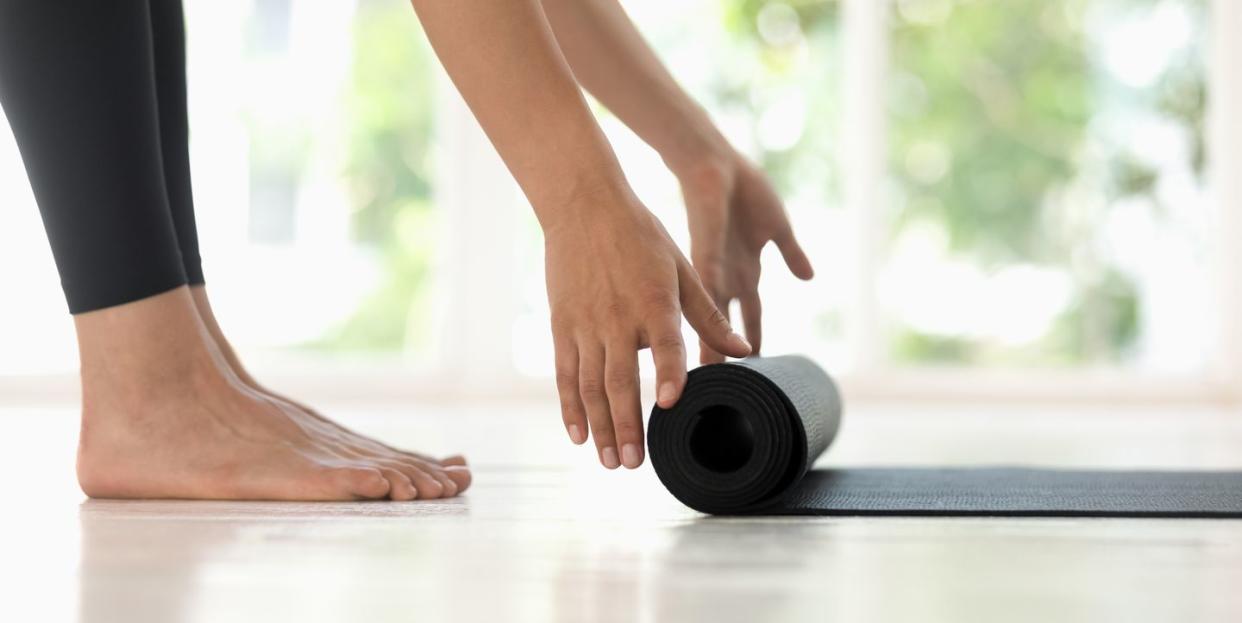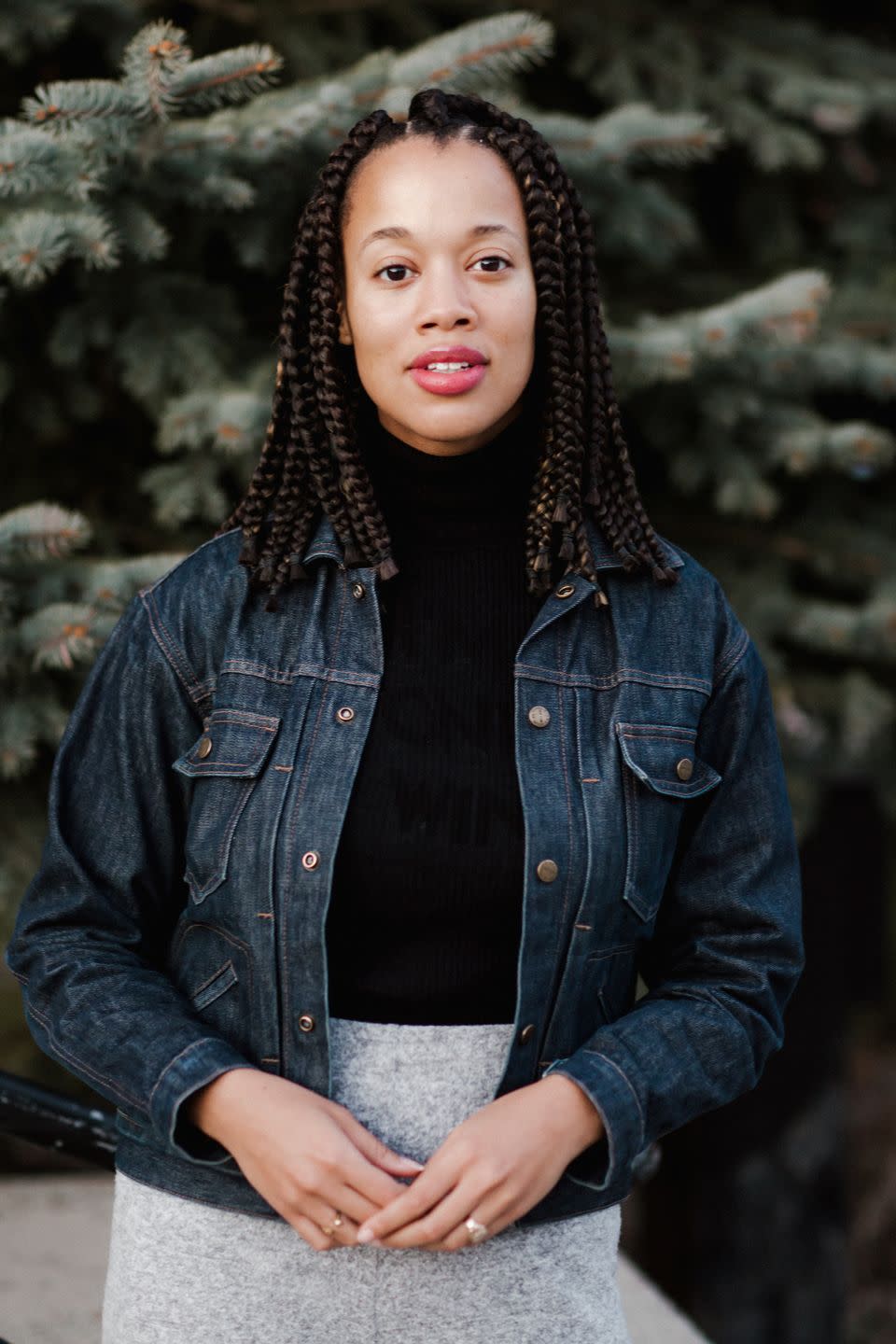Tips to Help You Start Meditating When Everything Seems Overwhelming

For some, finding a way to slow down and live your best life might mean reading an addicting new book or binging a feel-good TV show. For others, it could be the art of meditation, the practice of mindfulness that archaeologists can date back to as early as 5,000 BCE.
But while some have mastered the practice for thousands of years, I've been struggling to learn how to start meditating. And I've felt the urge to do so now more than ever amidst the uncertainty spurred by the coronavirus pandemic. I've even downloaded meditation apps.
As a chronically anxious person, I have what some might call an overactive mind. My thoughts constantly jump from my work responsibilities, to my monthly bills, to that awkward thing I said when I was 12, to what I'm wearing next Tuesday, to the crazy disease I've diagnosed myself with courtesy of WebMd.
Yes, I even exhaust myself, and they're my own thoughts. Which is why the concept of meditation and its benefits intrigue me. According to the National Center for Complementary and Integrative Health (NCCIH), the physically and mentally calming practice doesn't just lessen symptoms of anxiety and depression, but there's also evidence that supports the benefits include helping physical ailments, like reducing blood pressure or chronic pain caused by disorders like irritable bowel syndrome.
Not to mention, if you take one scroll through social media, you'll probably agree that it seems like everyone has suddenly taken up meditation. A 2017 National Health Interview Survey even found that the amount an average American adult meditated in a year's time tripled from 2012 to 2017.
But despite attempting the practice during my weekly yoga classes or in my spare moments, I've found it difficult to consistently calm my mind, with anxiety still finding a way to creep into my quiet time.
To help work towards welcoming a little more peace into my life, I consulted Lauren Ash, founder and executive director of the lifestyle brand Black Girl in Om. As a meditation and yoga guide, Ash's company works to promote holistic wellness, self-care, and self-empowerment, specifically for women of color.

Since I'm a Black woman currently lacking in one of Ash's many areas of expertise, I thought she'd be the perfect person to break down the meditation basics, providing steps to approach the practice in a way that didn't seem overwhelming. The first thing she taught me? Struggling to find my inner zen is not out of the ordinary.
"The idea of mind chatter and the incessant thoughts that come in when we try to get silent and gift ourselves the opportunities to turn inward—that's completely normal," Ash says. "That is in fact what our brains are great at. If we did not have a brain that had a function of thought, then we wouldn’t be experiencing life as many of us do, which is navigating decision making and having conversations with ourselves and with our loved ones."
While that made me feel incredibly relieved, I was still looking for meditation how-to's, which Ash was more-than-willing to share.
1.How can you can start meditating?
"What I’m really invested in is providing more accessible ways to approach the practice of meditation and to not over-intellectualize it," says Ash. "Especially in the West, where we’re talking about it so much, but we’re not doing it."
As Ash details in the following steps, there is no one box everyone has to to fit into when it comes to meditating. Putting time towards finding a unique way to practice that's personalized to you can also de-mystify a task that can sometimes seem daunting. "As with most things in life, let’s talk about it in a way that works for each of us, because one style of meditation may be my favorite, and give me all the peace and rootedness that I need, but that might be the kind of meditation that stresses you out."
2. Why do you want to meditate? Discover your intention.
Ash advises you take a moment to reflect on why exactly you're searching for a calming outlet. The reasoning will not only inform the type of meditation techniques that could work for you—yes, there are different kinds—but it will help you be more in-tune with your physical state. Ash also says your cause could be anything from physical discomfort, to stress, to the feelings of consistent powerful emotions like fear and doubt.
"Maybe yours should be a kind of meditation infused with the practice of gratitude that would really allow you to have a mindset shift and a perspective on what’s happening in your life," she says. "Or maybe you are someone who is plagued with chronic pain. There are different forms of mindfulness meditation that you can pick up and have you shift the relationship you have to the pain in your body."
When it comes to the different meditation techniques you can engage in, The Mayo Clinic names seven:
Guided meditation: Mentally visualizing a relaxing situation or place, using various senses like sight, sound, and smell to enhance the experience.
Mindfulness meditation: Ash names this as one of her preferred forms of practice. It's when you willingly live in the present, only aware of physical sensations like your flow of breath. Emotions and thoughts are allowed, but aren't judged. "It allows me to take inventory of where I’m at right now without necessarily trying to change it," she says. "Rest will deepen, the body will soften, and the mind will start to quiet a little bit more.
Yoga: A more familiar exercise, yoga's various poses and breathing techniques encourage you to focus on balance, physical flexibility, and a calm mind.
Mantra Meditation: The repetition of a singular word or phrase that is spoken quietly to encourage concentration.
Tai chi: A gentle, paced form of Chinese martial arts that's comprised of a series of specific movements.
Transcendental meditation: Intended to minimize physical and mental effort, you quietly repeat a personal mantra in a particular way in order to achieve ultimate peace and relaxation.
3. Set a realistic goal, starting with meditating for 2 minutes a day.
Ash explains that it's completely OK to not dive right in and commit yourself to intense, extensive sessions. You're allowed to pace yourself—because any time is better than none.
"For someone who’s beginning with meditation, I would honestly say practice daily for two minutes—which seems so short, but you’re talking about slowing down, quieting the mind, and going inward...so daily for two minutes, and then building up from there. Or even weekly dedicating yourself to one day—maybe it’s just Sunday for 10 minutes."
4. Live in the moment to recognize the benefits.
Following your practice, it's important to take the time to reflect on the experience. Ash recommends briefly journaling afterwards or speaking with a friend you trust. Process and engage with the emotions that may follow meditation, instead of "putting pressure on yourself to better yourself," Ash explains.
"A lot of times with mediation, some really dark things will come up. You might really notice how stressed out you are, or you might have a memory of something painful, or you might grow and have closer awareness with something you’ve been suppressing. And the goal then is to stick with that. Not to push it away, not to compartmentalize, but to allow."
5. What should you think about? First, focus on your breath.
Even after all of this, it can still be tricky to live in the moment, as the same pesky thoughts seemed to always have a way of creeping back. But Ash had a simple trick to remedy that: breathe.
"In yoga pranayama—Sanskrit for breath—literally translates to 'life force energy...' It’s one of the most powerful gifts that we have, and one that we most take for granted."
She advises to count your breaths to slow racing thoughts, focusing on fuller, longer exhales that then flow into steady inhales.
"That can literally be a subtle, loving reminder for the body to let go. Most of us are holding on to things we don’t need to be holding onto. If you are cultivating a steady, even breath, you're evenly creating balance between the body, mind, and spirit."
A post shared by Black Girl In Om (@blackgirlinom) on Jan 23, 2019 at 11:36am PST
6. Whether it's your bed or outdoors, make sure you're in your happy place.
Environment is key to a well-rounded meditation practice, and you can find time and any location of your own that allows security. Maybe it's a dedicated room in your home, a walk-in closet, or a beautiful park. This could even mean that mindless parts of your daily routine—like brushing your teeth, tidying up, or riding the train on your morning commute—can be turned into moments of calm.
"Some of us find ourselves in home situations that maybe aren’t what we want right now. With families, it’s really tough to feel like you can take that time away when you have children or a partner. But I do encourage as much as possible to create a space that is just for you and your quiet time and your meditation time."
Don't be afraid to decorate a bit either. Ash says she personally uses plants or ambient music to enhance her meditation. And one trick she has up her sleeve? You don't have to close your eyes during practice. Sometimes you can use a candle to focus on instead, zeroing in on the flickering flame as a point of concentration.
"Provide yourself a beautiful calming space to be supported in your practice."
As for me, after hearing Ash's tips, I'm eager to begin my journey towards some much-needed tranquility. I already have my happy place in mind (which I'll keep to myself, thank you very much). And when I head to my next yoga class, I'll have these tips in my back pocket to improve my meditation sessions.
But the one mantra that I now know is completely necessary to repeat over-and-over again? That first step: "Don't overthink it."
For more ways to live your best life plus all things Oprah, sign up for our newsletter!

